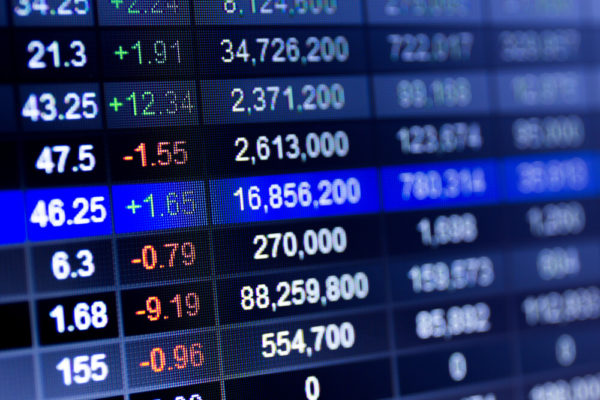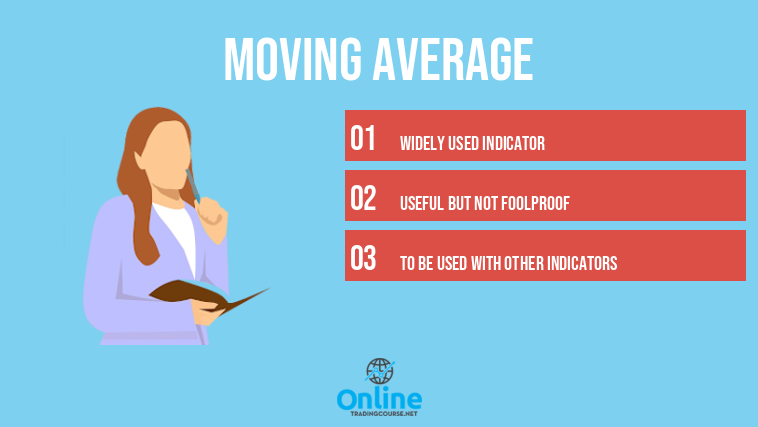
Moving Average
Which is the easiest trading indicator ever used in online trading? Obviously, it is the simple Moving Average. Online trading professionals have always used it to do market analysis on any financial asset. It has always returned data and information that is valuable to investors.
The Moving Average is one of the first indicators ever created. Ever since the markets went global and organized into stock exchanges, analysts had to interpret the price trend and soon discovered that the easiest way to do it was to draw a line which would cleanse the market from its background noise.
Shortly after, this line took the name of “Moving Average”. Thanks to its immediacy and simplicity of use, it quickly became the most used analysis tool in the world and is still very effective today for trading on financial markets.
Although this tool also has its strengths and weaknesses and is not a perfect indicator, almost no other analysis tool allows you to interpret a trend with the same speed and precision. Thanks to it, a glance is enough to be able to read the intentions of buyers and sellers on the markets.
Before starting, we would like to point out that there is an opportunity to copy, in a completely automatic way, what the best traders in the world do.
How? Thanks to eToro: not only is one of the best online trading platforms available today, but it provides the Copy Trading system that allows you to identify the traders who in the past have earned a lot in the past (with the lowest risk) and then copy them automatically.
In practice, thanks to eToro, beginners can get from the first day the same results as the best professionals in the world and can also learn to trade by observing live what these great experts are doing.
You can sign up for free on eToro by clicking here.Thanks to this guide, you can find out everything you need about the Moving Average. If you are looking for a trading tool that helps you to improve your trading performance and make your trades more precise and successful, you have just fount it. We advise you not to miss the rest of the guide and discover the secrets that made the Moving average famous among all professionals.
Index
Moving Average: what is and how to use it
The moving average is a common technical indicator. In technical analysis experts use it regularly because it is quick and easy to calculate, it is only a series of data. The average is calculated by adding a series of values and dividing everything by the number of observations made.
Moving averages are certainly to be used as part of your investment strategies. They can be used alone or with other moving averages obtained by following different calculation methods, this changes their characteristics and uses.
From moving averages you can get operating signals that indicate the best time to enter or exit the market (a similar thing is done automatically by Expert Advisors). Such signals can help the trader both to limit losses and to increase profits. This is because with a moving average, it becomes easier to interpret the market and understand in which direction the price will move in advance.
Like most indicators, it was also designed overseas, its common form of use among traders is to determine the market course on the various assets (market trend or trend) by freeing the price charts from random spikes.
How Moving Average works
The moving average analyzes the movements of the market prices, it takes into account the price history as it has evolved over the last few trades. Thanks to these analyzes it also helps to determine the support and resistance levels of the price.
Asset changes are measured by the moving average based on historical prices to determine future prices. A merit and defect at the same time of this tool is the fact that it offers “delayed” signals, i.e. signals that have a certain delay. If this feature is not much appreciated by professionals, it is so for beginners.
Receiving late signals is not the best for a professional trader because his aim is to always take advantage of trends as soon as they arise. Instead, a beginner may be happy to use the moving average because, even if it sends delayed signals, they are more reliable than those who anticipate the price too much.
The calculation of the Average
The simple moving average is constructed by adding up a certain number of market session closing data. The period is defined by the analyst and also depends on the time frame chosen for the trading operations.
Basically, if you choose to trade short term, the graph can be set in M1 (that is a 1 minute graph). In this case, a new closing of the price is generated every minute, which must be taken into account by the analyst for the calculation of its moving average.
The formula is so conformed:
Mt = (Pt + Pt – 1 + Pt – 2 + ……….. Pt – n + 1) / n
In the formula, the abbreviations used stand for:
Mt: moving average value at time t
p: price or value of the reference index
n: number of observations (amplitude of moving average)
The average is so called because it represents an average of a number of observations, but it is also called “moving” because it can always return fresh data to those who use it. Just remove the last the last observation in order of time and enter the freshest data to keep it updated.
The function obtained from the calculation of the average is a simple representation of the reference index which highlights only some particular points of the price trend and eliminates the so-called “market noise”.
The function tends to dampen the spikes of the most irregular prices and this effect becomes very evident, especially when the length of the average increases. The average trend is very regular because speculative peaks are eliminated.
Those who use the moving average do so precisely with the intention of eliminating the random elements that enter the price formation and provoke the exasperation of the movements. Disturbing elements must be eliminated in order to arrive at a clearer and more linear market reading.
The only problem in calculating it, is that all the elements included in its calculation have the same importance. So, older values have the same importance as the freshest market data.
The problem is greater when moving averages over 50 periods are used, these tend to delay the reversal of the trend with respect to the market, causing many problems for the analyst.
How does the moving average look like?

Are you wandering what it looks like? Looking at the graph above, you can get a very clear idea. What you see is the classic price chart of any good or market security.
It consists of red and blue Japanese candles. The blu candles are those that closed with a bullish market, the red ones are the bearish type candles. So, the two lines in the form of sinuous curves, that you see moving along with the price, are two moving averages.
They have a different form and follow the price differently because the analyst has used different calculation formulas to display them on the graph. In any case, as you can see, the moving average follows the price constantly in its course and the hottest points, that concern it, are always those in which it comes into contact with the price.
In this graph in particular, we have identified in the points A and B, two intersections of the moving average with the price. In the first case, the contact let to a short-term bullish trend, in the second, instead, we can observe that the intersection with the price generated a strong bearish trend.
Select the moving average
In order to use the moving average, all you need to do is select the indicator on your trusted trading platform. In general, when you do this, the platform immediately displays a second menu for calculating the average itself. Here professionals can decide to make changes to the default values, if they wish.
Generally, you choose to make changes when there are particular market conditions that require specific attention, or you can change the calculation data according to your investment style. In any case, we always advise beginners to avoid changing data and leaving the default calculation.
Once you exit the moving average menu, it will appear on the price graph and, from that moment on, you no longer need to touch it until the end of your trading session. The average will automatically update and continue to provide pricing data.
Other types of moving average
Is there only the simple moving average? Actually, other moving averages are also widely used by analysts. All of them have specific characteristics that we will now explain; all of them are used for different purpose in the market negotiation phase.
1 – Weighted Moving Average
Weighted moving average was invented precisely to overcome the classic problem of moving averages, namely the fact that they give the same value to all results.
To calculate an average of this type, it is expected that, considering an average of 10 periods, the closing of the price found on the 10th day will be multiplied by 10, that of the 9th day by 9 and that of the 8th day by 8 and so all other average values.
In this way, the freshest values have a greater importance in the graphic representation of the moving average, the total must then be divided by the sum of the multiples, for example, in this case, it must be divided by 1 + 2 + 3 …= 55.
Despite the calculation variable, sometimes even this moving average cannot give an instant idea of what is happening on the market.
2 – Exponential Moving Average
The Exponential Moving Average is used through a really complex calculation system, always designed to overcome the basic defects of the simple moving average. Each price receives a different weight, a larger one receives the most recent data and a smaller one the older data.
But, although little importance is given to past prices, they are still included in the calculation. The exponential moving average remains the most difficult to generate and, in fact, it can only be used through a computer, because of the difficulty of the calculations to obtain it, too difficult for any analyst to do.
3 – Adaptive Moving Average
When using a moving average, one of the problems we face is the period to choose for our analysis. While fast moving averages are more effective in low volatile markets, slower moving averages are ideal for trading on markets that have a well-defined trend and that move with volatility.
Just to remedy the different moving averages to be used in various contexts, Perry Kaufman tried to introduce an adaptive moving average, that is capable of adapting to market conditions. Kaufman’s average is quite capable of changing based on the market volatility rate.
Also here the calculations are very difficult to do, because they are based on important elements of statistics and mathematics. The average can also be calculated on the basis of an efficiency ratio. This compares the movement of prices with the level of volatility.
When the efficiency ratio is high, the movement is greater than volatility and favors the faster average. When it is low, volatility is greater than the movement and this favors a slower moving average.
Strategies and signals
Let’s now talk about what are the trading signals generated by the moving averages and the most common trading strategies used and created through their support. Analysts have a tendency to use moving averages as a sort of curved shape trend line.
This means that the moving average could be a kind of support and/or price resistance. Based on this assumption, operational signals are formed to be exploited in the investment phase on any asset. Let’s see the detail of the signals generated and the key moments to be observed on the markets:
- Buy signal: when prices rise above the moving average and therefore intersect it from the bottom upwards, a classic buy signal is generated.
- Sell signal: when prices fall below the moving average you get a bearish signal and therefore it is better to open a sell position.
During the negotiation phase, you must pay close attention to the time span of the graph you are setting. The period used, in fact, greatly influences the reliability of the trading signals. If you choose a restricted period, the moving average will tend to stay very close to the price, so its signals will be much faster and more timely.
On the other hand, if you choose a large period, the average tends to stay far from the price, still offering a trading signals, but this time in an even more legible way. In the first case, there may be numerous false signals, with slower moving averages instead, the signals become much more reliable.
Double Moving Average
Instead of using the moving average only with the price, many analysts prefer to use a strategy that uses a double moving average to generate more reliable trading signals. In this case the signals are generated by the intersection of the two moving averages without taking into consideration the price.
The average is called “double” because as a trading indicator it is made up of two moving averages, one fast and the other slow. The fast one is generally calculated on the basis of 21 periods, while the slow moving average is calculated n the basis of 50 periods. These numbers can also change. There are traders who use one at 100 and other at 200 periods.
- Buy signal: there is a buy signal when the fast moving average pierces the slow one from the bottom up.
- Sell signal: there is a sell signal when the slow moving average exceeds the fast moving average from top to bottom.

In the graph above, you can see a sign of entering the short market. The fast moving average, green colored, exceeds the slow one from top to bottom, sending a clear bearish signal which is then punctually respected by the market.
Read also: Pivot Point
Average Channels
Moving averages calculated over different periods can be used to create channels that include and contain the price. Prices always fluctuate within the channel which is therefore called the “envelope”.
In this case, an analyst must be able to recognize the percentage variations appropriate to the type of market on which the channel was formed. In reality, the channel consists of only one moving average, the central one. It is then moved up or down as needed.
The channel will then be used to determine when the price has moved far from its central moving average. The development principle is similar to that of the Bollinger Bands.
Read also: Bollinger Bands

Conclusions
In this guide you had the opportunity to discover the potential and use of the simple moving average. It is a fairly basic yet highly effective indicator. Its potential for trading is enormous and all the winning trades that the great traders have done in the past demonstrate this.
Generally, we tend to think that trading tools must be complex and difficult to use, but the moving average shows that sometimes it is not necessary to be great mathematics or statistics professors to calculate it. Success factors in a market also depend on the attitude of the trader and his risk management.
It is a widely used indicator based, precisely, in the average of a predetermined number of values.
Usually, we take a moving average defined as “fast”, with few periods, to cross it with a “slow” moving average, that is, with several periods taken into consideration. The upward or downward crossing of the fast and slow moving average will offer operational ideas.
Many Traders use this basic strategy to invest. However, it is a “simple” indicator so the signals offered are excellent but not foolproof.
The suggestion of many analysts consists in mixing the signal of the moving average with that coming from another indicator (RSI and MACD above all). In the event of a unique signal, it will be possible to enter the market.
